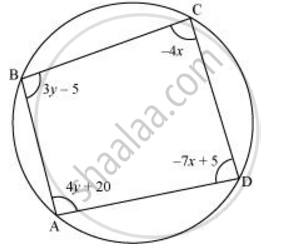Advertisements
Advertisements
Question
The sum of a two digit number and the number obtained by reversing the order of its digits is 99. If the digits differ by 3, find the number.
Solution
Let the digits at units and tens place of the given number be x and y respectively. Thus, the number is `10 y + x`.
The two digits of the number are differing by 3. Thus, we have ` x - y = +-3`
After interchanging the digits, the number becomes ` 10 x + y`.
The sum of the numbers obtained by interchanging the digits and the original number is 99. Thus, we have
` ( 10 x + y)+ (10 y + x)=99`
` ⇒ 10 x + y + 10 y + x = 99`
`⇒ 11 x + 11y = 99 `
` ⇒ 11( x + y )= 99`
` ⇒ x + y 99/11`
` ⇒ x + y =9`
So, we have two systems of simultaneous equations
` x- y = 3`
` x + y = 9`
` x - y = -3`
` x + y = 9`
Here x and y are unknowns. We have to solve the above systems of equations for xand y.
(i) First, we solve the system
` x - y = 3`
` x + y = 9`
Adding the two equations, we have
` ( x - y) + ( x + y) = 3+ 9`
` ⇒ x - y + x + y = 12`
` ⇒ 2x = 12`
` ⇒ x = 12/2`
` ⇒ x = 6`
Substituting the value of x in the first equation, we have
` 5 - y = 3`
` ⇒ y = 6-3`
` ⇒ y = 3`
Hence, the number is`10 xx 3 + 6 = 36`.
(ii) Now, we solve the system
` x - y = -3`
`x+y=9`
Adding the two equations, we have
`(x -y)+(x+y)= -3 +9`
` ⇒ x - y + x+ y = 6`
`⇒ 2x = 6`
` ⇒ x = 6/2`
` ⇒ x = 3`
Substituting the value of x in the first equation, we have
` 3-y = -3`
`⇒ y = 3 + 3 `
` ⇒ y = 6`
Hence, the number is `10 xx6 + 3 = 63`.
Note that there are two such numbers.
APPEARS IN
RELATED QUESTIONS
Solve `\frac { 2 }{ x } + \frac { 1 }{ 3y } = \frac { 1}{ 5 }; \frac { 3 }{ x } + \frac { 2 }{ 3y } = 2` and also find ‘a’ for which y = ax – 2
Solve the following pairs of equations by reducing them to a pair of linear equations
6x + 3y = 6xy
2x + 4y = 5xy
Solve the following pair of linear equations: px + qy = p − q, qx − py = p + q
Solve the following pair of linear equations.
`x/a-y/b = 0`
ax + by = a2 + b2
ABCD is a cyclic quadrilateral finds the angles of the cyclic quadrilateral.

Find the value of following determinant.
`|(-1,7),(2,4)|`
Find the values of following determinant.
`|(7/3,5/3), (3/2, 1/2)|`
If 2 is added to the numerator of a fraction, it reduces to 1/2 and if 1 is subtracted from the denominator, it reduces to 1/3. Find the fraction.
A father is three times as old as his son. After twelve years, his age will be twice as that of his son then. Find the their present ages.
Two years ago, a father was five times as old as his son. Two year later, his age will be 8 more than three times the age of the son. Find the present ages of father and son.
